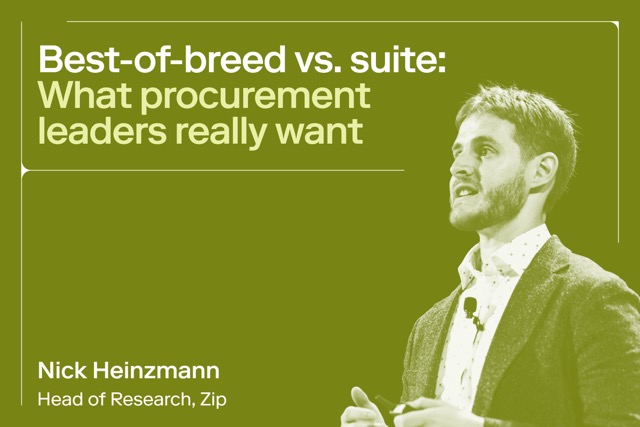
What are procurement risks? And how to mitigate them
Discover strategies to navigate procurement risks and safeguard your processes.

From semiconductor shortages impairing car manufacturers to sudden energy price spikes squeezing profit margins, the modern business landscape is a minefield of procurement risks. These aren't just theoretical concerns; they're daily realities forcing companies to scramble for alternatives, renegotiate contracts, and absorb unforeseen costs.
This article delves into the multifaceted nature of procurement risks, exploring everything from supplier financial instability and quality control issues to regulatory changes and ethical sourcing dilemmas. We'll dissect the various categories of risk, providing practical insights and actionable steps to help you build a resilient procurement strategy.
What is procurement risk management?
Procurement risk management is the process of identifying, assessing, and mitigating risks throughout the procurement cycle. It plays an important role in safeguarding organizations against potential pitfalls that can adversely affect their operations, profitability, and reputation.
Procurement risk management strategies evolved significantly in the digital age, shifting from primarily focusing on supplier reliability to encompassing complex cyber threats and data security vulnerabilities. Emerging risks, unlike the ones we’ve seen in the past, often involve intricate, interconnected systems and require sophisticated, real-time monitoring and analysis to effectively mitigate their impact.

What are internal and external risks in procurement?
Procurement risks can be broadly categorized into internal risks and external risks.
Internal Risks
Internal risks are problems that originate inside your organization and can pop up at any stage of the procurement process, from initial needs analysis to supplier payments and recording. For example:
- Process inefficiencies: Flaws in the procurement process that lead to delays, errors, and increased costs
- Compliance failures: Non-adherence to regulations and internal policies that can result in legal repercussions
- Internal fraud: Dishonest activities by employees that can undermine the integrity of procurement operations
To prevent internal risks, companies need to focus on a few key internal policies, like:
- Industry standard policies: These policies ensure your products or services meet a certain level of quality, safety, or environmental responsibility that’s standard for your industry. For example, the tech sector has industry standard policies in place to safeguard user information.
- Financial control policies: Spend controls help keep track of money and prevent fraud. This might include setting clear spending limits for individuals or departments, requiring approvals for certain purchases, conducting regular audits, and implementing a “segregation of duties” system where different people are responsible for different stages of the purchasing process.
- Ethical guidelines: These rules promote honesty and fairness in all business dealings. They’re essential for maintaining trust with customers, suppliers, and employees. You’ll want to include policies against bribery and corruption, avoiding conflicts of interest, guidelines for responsible sourcing, and confidentiality and data protection at minimum.
External Risks
External procurement risks are threats originating outside an organization that can disrupt the procurement process and impact business operations.These risks are often beyond the procurement team’s control, and can sometimes be difficult to expect and manage. Examples include:
- Supplier financial instability or failure: A key supplier going bankrupt or experiencing financial difficulties
- Geopolitical factors: Political instability in supplier countries affecting supply continuity, such as trade wars or sanctions affecting supply chains
- Market volatility: Fluctuations in prices and demand that impact procurement costs
- Environmental factors: Natural disasters, pandemics, and other environmental situations and regulations that affect supply availability and costs
- Regulatory changes: New laws or regulations impacting import/export, environmental standards, or product safety
- Cybersecurity threats to suppliers: Data breaches or cyberattacks targeting supplier systems
- Logistics disruptions: Port congestion, transportation strikes, or delays in shipping
- Ethical sourcing issues: Concerns about labor practices, environmental impact, or human rights violations in the supply chain
It's important to recognize that external procurement risks are constantly evolving. Here are some global examples within the last five years:
- The Russian invasion of Ukraine has caused major disruptions to energy markets, grain supplies, and the availability of critical metals like palladium. Sanctions have also significantly impacted trade flows.
- The COVID-19 pandemic caused widespread supply chain disruptions, including factory closures, transportation delays, and shortages of critical materials. These disruptions continue to have ripple effects.
- Ongoing disputes between the U.S. and China over tariffs, technology transfer, and intellectual property have led to supply chain diversification and increased costs for many businesses.
- Backlogs at major ports, particularly during the pandemic and most recently the October 2024 port strike, have resulted in lengthy delays and increased shipping costs.
- Severe droughts in regions like California and parts of Europe and North Africa have led to crop shortages and increased food prices.
Top procurement risks to look out for
While many issues cannot be fully planned for, if you understand the most common procurement risks, you may be able to effectively minimize or manage their impact. Here are some common solvable risks that can affect procurement strategy.
- Supplier dependency: Relying heavily on a single supplier can be risky. If the supplier fails to deliver, it can halt your entire supply chain, causing significant disruptions.
- Contractual risks: Poorly drafted contracts can expose your organization to financial risks and legal liabilities. It's important to have clear, comprehensive contracts that protect your interests.
- Quality issues: Receiving substandard goods can affect your product quality and customer satisfaction. Ensure strict quality control measures with suppliers to minimize this risk.
- Cost volatility: Market fluctuations can lead to unexpected cost increases, impacting your budget and profitability. For example, the dramatic surge in egg prices due to avian flu outbreaks and supply chain disruptions illustrate how quickly market conditions can change, requiring businesses to adapt their procurement strategies to avoid significant financial strain. Effective forecasting and cost management strategies can help mitigate these situations.
- Regulatory shifts and EMEA compliance: In the EMEA region, evolving regulatory landscapes present unique procurement risks. Staying on top of changes in data protection, sustainability reporting, and industry-specific regulations is more important than ever. There's a growing focus on transparency about where companies get their supplies, which means businesses in this region need to carefully check their suppliers and monitor them regularly. This adds complexity to the buying process.
How to identify potential and current procurement risks: Best practices
To manage and mitigate procurement risks and conduct supply chain management effectively, there are several best practices organizations should adopt.
Conduct risk assessments
A SWOT analysis is a helpful tool for identifying procurement risks. It involves looking at your company's strengths, weaknesses, opportunities, and threats. When applied to procurement, you can use it to pinpoint potential problems. For example:
- Strengths can show what you're doing well, like having strong supplier relationships.
- Under Weaknesses, you might list a heavy reliance on a single supplier, which exposes you to supply chain disruptions.
- Opportunities might reveal ways to diversify suppliers or adopt new technologies to improve efficiency.
- Threats could include things like rising material costs or new regulations.
To conduct the assessment, gather key stakeholders from procurement, finance, and operations. Brainstorm and list relevant factors for each SWOT category. Then, analyze how these factors interact. For instance, a weakness like outdated technology could amplify a threat like a cyberattack on a supplier.
By combining these insights, you can prioritize risks and develop strategies to address them. Regularly updating your SWOT analysis will help you stay ahead of emerging threats and capitalize on new opportunities.
Stress the role of audits
Regular internal and external audits are essential for uncovering procurement risks.
Internal audits examine your company's processes and controls, checking for things like compliance with policies, financial accuracy, and potential fraud. They can reveal weaknesses in your procurement workflow, such as inadequate supplier vetting or insufficient contract management.
External audits, conducted by independent parties, offer an objective view of your procurement practices. They assess your financial records, supplier relationships, and adherence to regulations, often uncovering risks that internal reviews might miss. Both types of audits provide valuable insights into your procurement operations, allowing you to identify and address potential problems before they escalate.
Prioritize supplier management
Strong supplier relationships are an under-appreciated way to minimize procurement risk. This means carefully selecting suppliers based on their reliability, financial stability, and ethical practices. Building strong relationships through clear communication and regular performance reviews allows you to address potential issues early.
Don’t forget to diversify your supplier base to reduce reliance on any single source, mitigating the impact of disruptions. Once you have your key vendors and suppliers, maintain close contact with them and get their takes on what they’re seeing in their industry. Their eyes are your ears!
Improve contract management
Many issues can arise if procurement contracts are unclear, inaccurate, or ineffectually maintained. To solve for contract risk mitigation, make sure all contract terms are clear, comprehensive, and regularly reviewed to reflect any changes in circumstances or regulations.
Centralizing contract management allows for better tracking and oversight, ensuring all parties adhere to the agreed-upon terms. You can also use Zip’s AI-enhanced document management solution to flag risky terms worth reconsidering.
Collect stakeholder feedback
Stakeholders, like department heads, finance teams, and end users, have firsthand experience with the procurement process and can offer valuable insights into potential problems. Regularly asking for their input helps identify issues that might not be apparent from data alone. For example, they can highlight recurring supplier performance issues, identify bottlenecks in the approval process, or point out inconsistencies in product quality.
This feedback loop lets you address concerns proactively, improve communication between departments, and make sure procurement decisions align with the needs of the entire organization. By actively listening to stakeholder feedback, you can build a more responsive procurement strategy that minimizes risks and maximizes efficiency.
Implement continuous monitoring
Continuous monitoring proactively identifies and addresses procurement risks before they escalate. It involves tracking key performance indicators (KPIs), like supplier delivery times, quality metrics, and market price fluctuations, in real time. By continuously analyzing this data, you can detect potential issues early, such as supplier performance declines or sudden price increases.
Automated procurement software can streamline this process by providing dashboards and alerts that highlight deviations from expected patterns. These systems can automatically track contract compliance, monitor supplier financial health, and even flag potential fraud. By using these tools, you can gain better visibility into your procurement operations so you can make informed decisions and take timely action to mitigate risks.
Emerging digital risks in procurement
Digital procurement is fast and efficient, but it also introduces a new set of procurement risks. You've got to watch out for things like hackers targeting your suppliers and the risks that come with using AI to make buying decisions. Knowing these new digital threats is key to keeping your business safe and your data secure.
Cybersecurity threats
As e-procurement systems become more commonplace, the risk of cyberattacks increases. Protecting sensitive data and ensuring the security of procurement software is incredibly important to avoid breaches that could disrupt the supply chain and damage reputational integrity. More countries are increasingly adopting new policies, like the Digital Operational Resilience Act (DORA) in the EU, to strengthen cybersecurity requirements and protect sensitive financial and operational data within digital supply chains.
Data privacy issues
Procurement processes involve the exchange of significant volumes of sensitive data, like financial records and proprietary product plans. Failure to follow data privacy regulations like GDPR can result in serious fines and damage stakeholder trust. With the growing reliance on cloud-based procurement systems and advanced data analytics, the need for robust security measures to mitigate data breaches is more important than ever.
Rapidly changing technology landscapes
Keeping up with technological advancements can be challenging for procurement teams. Organizations must continuously adapt to new tools and systems to stay competitive. The challenge of managing rapidly changing technology landscapes can lead to increased costs and inefficiencies if not properly managed.
Fortunately, Zip has pioneered procurement innovation for years, so clients are always on the cutting edge of technology, safety, and opportunity for procurement to accelerate business growth.
Why is procurement risk management important?
Think of your procurement risk management strategy as your business's safety net. It's about spotting potential problems before they hit, like supplier issues or unexpected price hikes, so you can keep things running smoothly. Without it, your company could face costly disruptions, damaged relationships, and even legal trouble.
Risk management in procurement can help:
- Ensure business continuity: By identifying potential risks and implementing mitigation strategies, you can stop problems before they shut you down.
- Maintain a competitive advantage: Proactively managing risks allows you to handle market changes better than your rivals.
- Secure your supply chain: Effective risk management ensures a reliable supply of goods and services, so you’ll always have what you need to continue production.
- Protect your financial integrity: Managing procurement risks helps avoid cost overruns and financial losses, helping your organization stay afloat during uncertain times.
Leverage Zip to mitigate procurement risks
Bottom line: You can't afford to ignore procurement risks. Whether you’re navigating supply chain disruptions or data breaches, proactive risk management is the only way to safeguard your business's stability and future growth.
That's where Zip for Procurement can help. It's built to spot problems before they happen. With features like automated risk assessments that flag potential supplier vulnerabilities and robust compliance and policy management features that ensure adherence to evolving regulations, Zip helps you minimize disruptions and optimize your procurement processes. Request a demo today to see how Zip can strengthen your risk management strategy.

Maximize the ROI of your business spend

Enter your business email to keep reading



























.webp)




















.avif)












.avif)










.webp)





.avif)












.avif)
